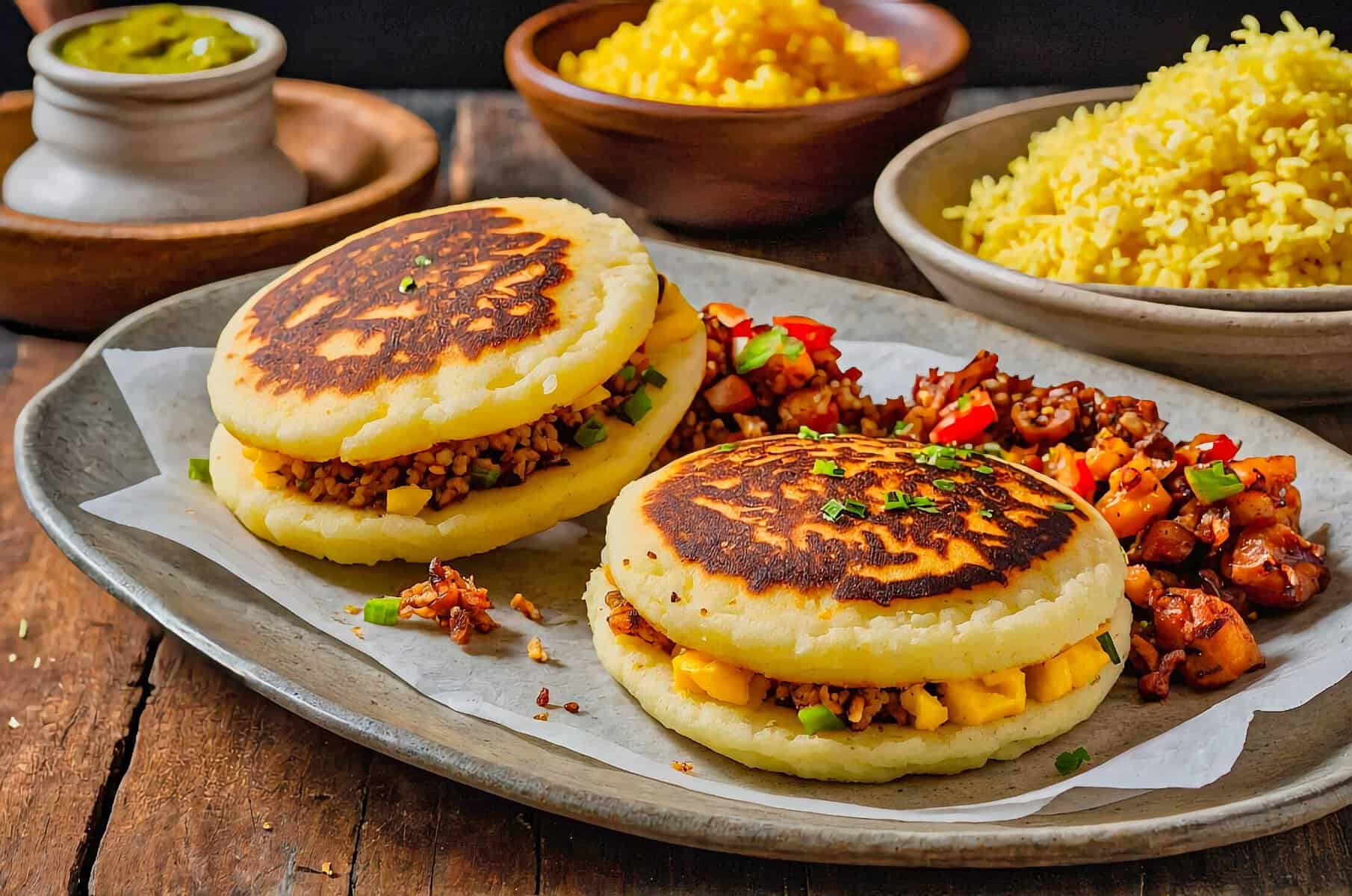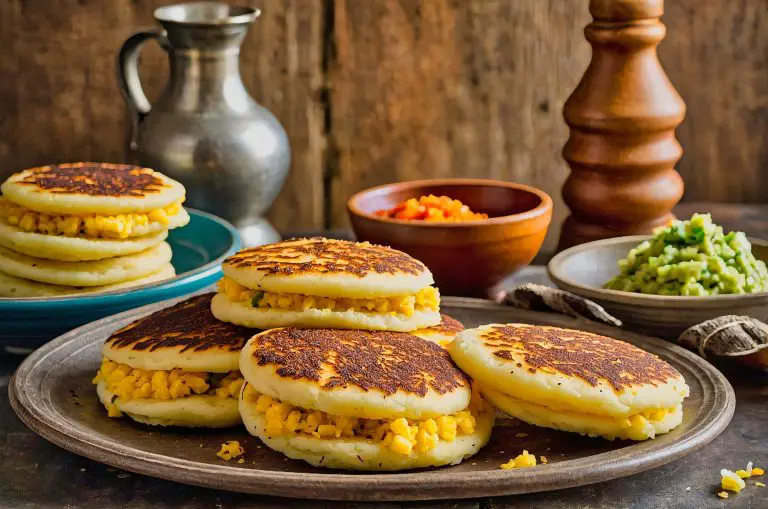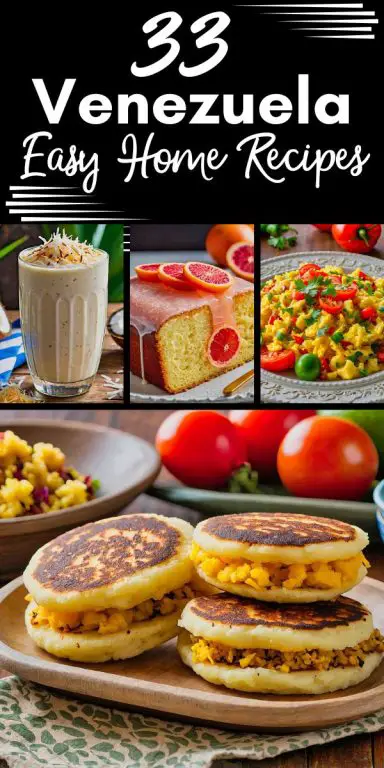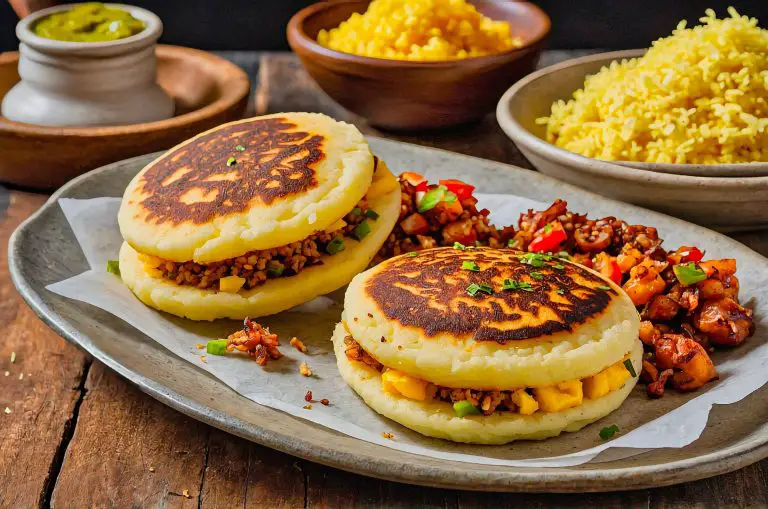Venezuela Arepas Recipe
When I went to Barquisimeto I learned the Venezuela Arepas recipe from a small restaurant owner. Barquisimeto, “Musical Capital of Venezuela,” is located in the west of the country. Flat terrain, colourful colonial-style buildings and a mixture of urban and natural attractions mark the city.
Famous landmarks include the Obelisco de Barquisimeto (the symbol of the city) and the Flor de Venezuela (a flower shaped structure). Locals and visitors alike can enjoy the Mercado Terepaima with its wide variety of fresh produce.
The restaurant owner showed me the Venezuela Arepas recipe, which is a staple in Venezuelan cuisine. Arepas are round, flat cornmeal cakes grilled, baked or fried with fillings. It started with cornmeal, water along with a little salt. The dough was then patties and cooked till golden on the outside and firm on the inside. We filled the arepas with shredded chicken, cheese and avocado – all common fare in the region.
I tried the Venezuela Arepas recipe for the first time and it tasted and texture was interesting. The arepas were slightly crispy on the outside and tender inside and were a good vessel for the fillings. The ingredients were balanced well, with the fresh avocado contrasting with the salty chicken and cheese. The simplicity of the dish allows for endless variations and is a favourite of locals.
Barquisimeto itself has much to see and do besides its cuisine. Festivals and performances throughout the year celebrate the city’s musical heritage. The Museo de Barquisimeto offers information about the region and culture and the nearby Parque Ayacucho is a place to relax. For nature lovers, the Valle del Turbio boasts nature reserves and hiking routes.
The Venezuela Arepas recipe is rooted in the local cuisine. Arepas can be consumed anytime of the day as a fast breakfast or a hearty dinner. Being able to prepare them in Barquisimeto allowed me to get to know the city’s cooking and taste the flavours that are emblematic of Venezuelan food culture.
Ingredients
2 Cup Warm Water
1 Tbsp Oil
1 Tsp Salt
2 Cup Masa Arepa, (Pan or GOYA brand, pre-cooked corn flour NOT masa harina)
Directions
- In a big basin, combine the water, oil, and salt. Soak the salt in the mixture.
Add the masa arepa slowly while stirring constantly. - Allow the dough to rest for 10 minutes after covering the bowl with a moist tea towel. In case the dough appears excessively dry to maintain its shape after resting, incorporate 1 tablespoon of water.
- Scoop out 6 equal portions of dough and roll out each one into a disc that is about 4 inches in diameter, or ½ inch thick.
To Grill Your Arepas
- Turn the heat up to medium-high on a cast-iron griddle. Before adding the arepas on the griddle, brush it with a little oil.
Seal the dough by cooking the arepas for three to five minutes per side. Once the arepas are golden brown and somewhat scorched, lower the heat to medium-low or medium and cook for another 8 to 10 minutes on each side, adjusting the griddle heat as needed. (When tapped, the arepas should have a little hollow sound and a little puffiness.) - Cool the arepas on a wire rack for approximately 10 minutes after removing them from the pan.
- Cut the arepas in half lengthwise with a sharp knife if you intend to stuff them.
Pile on top and enjoy when fresh!
To Bake Your Arepas
- Make sure your oven is preheated at 350F.
- To begin, brush oil onto a heated griddle and cook the arepas for three to five minutes per side, or until they are sealed.
- Next, bake the arepas for 18 to 20 minutes, or until they slightly puff up and make a hollow sound when tapped.
Ten minutes must pass before slicing the arepas. - Pile on top and enjoy when fresh!
To Fry Your Arepas
- For the arepas to be fried, you’ll have to make 12 rounds. Reduce the size of the discs until they are half an inch thick.
- In a big skillet, heat up 1 inch of oil. You want the oil to be around 370F.
- Fry the arepas for 10 minutes, or until they turn golden, in the heated oil.
- While the arepas are cooking, take them out of the hot oil and place them on a platter lined with paper towels.
Favorite Local Foods in Venezuela
Venezuela has a diverse and interesting food scene reflecting its history, geography and people. The local cuisine combines indigenous, African and European influences, with regional variations in flavors. From the lively streets of Caracas to the coastline and the plains, Venezuela has a food culture as varied as its landscape.
The most famous dish in Venezuela is the arepa. This versatile cornmeal cake can be grilled, fried or baked and it is served for Venezuelan breakfasts, dinners and lunches. Arepas typically contain cheese, ham, shredded beef, or chicken. Arepas are favorites everywhere in the country, whether as a quick snack or as a main meal. An example is the arepa reina pepeada, stuffed with a creamy chicken salad of avocado, mayonnaise and shredded chicken.
Another popular food in Venezuela is pabellon criollo, the national dish. Shredded beef, black beans, rice and fried plantains make this filling meal. The flavors – salty, sweet and savory – make pabell’n criollo a comfort food. In fact, it’s often served at special occasions and gatherings, as part of Venezuelan hospitality. Tender shredded beef is seasoned with a variety of spices and the beans are cooked through.
Venezuela’s tropical climate means that fresh fruits are plentiful; some of the locals favorite drinks are jugos naturales, fruit juices made from tropical fruits such as mango, guava, papaya and passion fruit. These juices are often fresh and found in homes, restaurants and street stalls. They cool off on a hot day and are a delicious symbol of Venezuela’s natural resources.
Street food is a must try if you want to try local flavors in Venezuela. Cachapas, for example, are thick corn pancakes that are usually stuffed with cheese. Made from fresh corn, cachapas are slightly sweet and savory and popular for breakfast or lunch. Yet another street food is empanadas, stuffed pastries stuffed with cheese, meat or seafood. They are deep fried and served hot with salsa de ajo (garlic sauce).
Hallacas are another traditional food associated with Christmas celebrations in Venezuela. These cornmeal parcels are full of pork, raisins, olives, chicken, beef, and capers and steamed in plantain leaves. The preparation of hallacas is a family activity and the dish has become a part of Venezuelan holiday traditions.
From the comforting pabellon criollo to the fruit juices and the arepa, Venezuelan food can be found in many flavors and textures. At home or on the streets, Venezuelan cuisine reflects the country’s culture and history.
15 Essiential Ingredients for Venezuela Cooking
Venezuelan cuisine is a delightful blend of indigenous, African, and European influences, with an emphasis on fresh ingredients and bold flavors. To create authentic Venezuelan dishes, it is essential to have a solid understanding of the key ingredients that are commonly used in everyday cooking. Here are 15 essential ingredients that form the foundation of Venezuelan cooking.
1. Corn: Corn is a staple in Venezuelan cuisine, with dishes like arepas, cachapas, and hallacas all featuring this versatile ingredient. The flour made from ground corn is used in a variety of forms, from dough to masa, to create both savory and sweet dishes.
2. Cornmeal: Cornmeal is crucial for making arepas, one of Venezuela’s most famous foods. It is also used in other traditional dishes such as empanadas and cachapas. The texture of the cornmeal helps create dishes with a perfect balance of crispy on the outside and soft on the inside.
3. Shredded Beef: Shredded beef is commonly used in Venezuelan cooking, particularly in dishes like pabellón criollo. The beef is typically cooked with a variety of seasonings and spices, then shredded to create a flavorful base for many meals.
4. Black Beans: Black beans are a key component in many Venezuelan meals, often paired with rice in dishes like pabellón criollo. The beans add depth and a rich, earthy flavor to meals and are a great source of protein.
5. Rice: Rice is a staple side dish in Venezuela, often served alongside meats, beans, or stews. It is commonly paired with black beans, creating the classic dish pabellón criollo. Venezuelans also enjoy rice with chicken, beef, or fish.
6. Plantains: Plantains, both ripe and green, are a staple in Venezuelan cuisine. They are used in a variety of ways, from sweet to savory. Fried plantains, known as tajadas, are a popular side dish, while mashed plantains are often served as part of the meal.
7. Cheese: Venezuelan cheese is often soft and mild. The most popular variety is queso blanco, which is similar to mozzarella. It is used in a variety of dishes, including stuffed arepas, cachapas, and empanadas. Venezuelan cheese is also enjoyed on its own or in combination with other ingredients.
8. Chicken: Chicken is another common protein in Venezuelan cooking. It is often used in dishes such as pollo en salsa (chicken in sauce) or added to arepas and stews. The mild flavor of chicken allows it to pair well with the bold seasonings typical of Venezuelan cuisine.
9. Pork: Pork is frequently used in Venezuelan cuisine, particularly in holiday dishes like hallacas. It is also common in stews and served with rice and beans. The rich, fatty flavor of pork complements the spicy and savory elements of many Venezuelan dishes.
10. Garlic: Garlic is a key ingredient in many Venezuelan dishes, providing a strong base flavor for meats, stews, and sauces. It is often used in marinades, and combined with onion, garlic creates a foundation for much of Venezuelan cooking.
11. Onions: Onions are a staple ingredient, often used in the preparation of salsas, stews, and meat dishes. They provide a sweet, aromatic flavor that complements the bold seasonings used in many Venezuelan recipes.
12. Tomatoes: Tomatoes are commonly used to make salsas, sauces, and stews. They add acidity and sweetness to dishes, balancing out the richness of meats like beef and pork. Tomatoes are essential in dishes like pabellón criollo and are frequently used in the preparation of sofrito.
13. Oyster Sauce: Oyster sauce is a key ingredient in many Venezuelan stir-fries and rice dishes. It adds a savory, umami flavor to meals and is commonly used in combination with soy sauce and other seasonings.
14. Cumin: Cumin is one of the most important spices in Venezuelan cooking, adding a warm, earthy flavor to meats, stews, and rice dishes. It is often used in combination with other spices like paprika and oregano to create the signature taste of Venezuelan food.
15. Limes: Limes are used extensively in Venezuelan cooking, both for their juice and zest. The acidity of limes is often used to balance rich flavors and to add a refreshing element to dishes. Lime juice is commonly used to marinate meats and seafood, and it is also squeezed over many dishes before serving.
These 15 essential ingredients form the backbone of Venezuelan cuisine, allowing home cooks and chefs alike to create the rich, diverse flavors that define the country’s culinary identity. From the ever-present cornmeal used to make arepas, to the savory spices that infuse the country’s stews, these ingredients are the key to preparing authentic Venezuelan dishes that reflect the country’s vibrant culture.
5 FAQs for the Venezuela Arepas Recipe
Q: What is the Venezuela Arepas recipe and how is it made?
A: The Venezuela Arepas recipe is a traditional Venezuelan dish made from cornmeal dough that is formed into round patties and cooked until golden and crispy on the outside. The arepas can be split open and filled with a variety of ingredients such as cheese, meats, or vegetables, making them a versatile and delicious meal or snack.
Q: Can I make the Venezuela Arepas recipe ahead of time?
A: Yes, you can make the Venezuela Arepas recipe ahead of time. After cooking, store the arepas in an airtight container at room temperature for up to two days. You can also freeze the cooked arepas, and then reheat them in the oven or on a griddle for a fresh, crispy texture.
Q: Can I use a different type of flour for the Venezuela Arepas recipe?
A: The Venezuela Arepas recipe specifically calls for pre-cooked white or yellow cornmeal, such as “Harina Pan.” Other flours, like regular cornmeal or masa harina, may not yield the same texture or consistency, so it’s recommended to use the correct type of cornmeal for the best results.
Q: What can I fill the Venezuela Arepas recipe with?
A: The Venezuela Arepas recipe is extremely versatile when it comes to fillings. Common fillings include shredded beef (Carne Mechada), cheese, black beans, chicken, or avocado. You can get creative with your fillings based on your personal preferences or dietary needs.
Q: How long does it take to cook the Venezuela Arepas recipe?
A: The Venezuela Arepas recipe typically takes about 20 minutes to cook, with each side being cooked for around 10 minutes until golden brown and crispy. If you prefer a softer inside, you can bake the arepas in the oven for a few extra minutes after pan-frying.

Venezuela Arepas Recipe
Ingredients
- 2 Cup Warm Water
- 1 Tbsp Oil
- 1 Tsp Salt
- 2 Cup Masa Arepa (Pan or GOYA brand, pre-cooked corn flour NOT masa harina)
Instructions
- In a big basin, combine the water, oil, and salt. Soak the salt in the mixture.
- Add the masa arepa slowly while stirring constantly.
- Allow the dough to rest for 10 minutes after covering the bowl with a moist tea towel. In case the dough appears excessively dry to maintain its shape after resting, incorporate 1 tablespoon of water.
- Scoop out 6 equal portions of dough and roll out each one into a disc that is about 4 inches in diameter, or ½ inch thick.
To Grill Your Arepas
- Turn the heat up to medium-high on a cast-iron griddle. Before adding the arepas on the griddle, brush it with a little oil.
- Seal the dough by cooking the arepas for three to five minutes per side. Once the arepas are golden brown and somewhat scorched, lower the heat to medium-low or medium and cook for another 8 to 10 minutes on each side, adjusting the griddle heat as needed. (When tapped, the arepas should have a little hollow sound and a little puffiness.)
- Cool the arepas on a wire rack for approximately 10 minutes after removing them from the pan.
- Cut the arepas in half lengthwise with a sharp knife if you intend to stuff them.
- Pile on top and enjoy when fresh!
To Bake Your Arepas
- Make sure your oven is preheated at 350F.
- To begin, brush oil onto a heated griddle and cook the arepas for three to five minutes per side, or until they are sealed.
- Next, bake the arepas for 18 to 20 minutes, or until they slightly puff up and make a hollow sound when tapped.
- Ten minutes must pass before slicing the arepas.
- Pile on top and enjoy when fresh!
To Fry Your Arepas
- For the arepas to be fried, you'll have to make 12 rounds. Reduce the size of the discs until they are half an inch thick.
- In a big skillet, heat up 1 inch of oil. You want the oil to be around 370F.





3 comments
Served with every meal in Venezuela, these little cakes are delicious.
I cant believe they didnt mention the secret ingredient in the Venezuela Arepas recipe! Everyone knows its what takes them from good to amazing. What do you think it could be?
I cant believe they didnt mention the secret ingredient in the Venezuela Arepas recipe! Its what really makes them stand out. I guess some things are meant to remain a mystery.